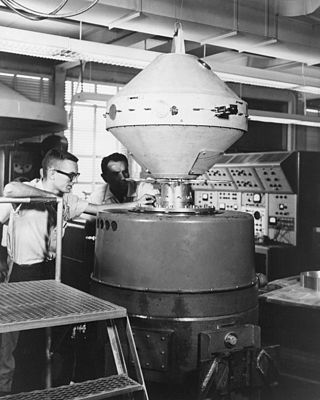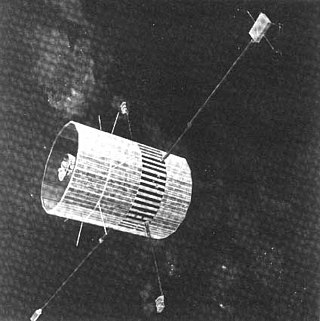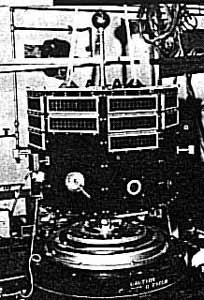
Explorer 35,, was a spin-stabilized spacecraft built by NASA as part of the Explorer program. Designed for the study of the interplanetary plasma, magnetic field, energetic particles, and solar X-rays, from lunar orbit.

Explorer 32, also known as Atmosphere Explorer-B (AE-B), was a NASA satellite launched by the United States to study the Earth's upper atmosphere. It was launched from Cape Canaveral on a Delta C1 launch vehicle, on 25 May 1966. It was the second of five "Atmosphere Explorer", the first being Explorer 17. Though it was placed in a higher-than-expected orbit by a malfunctioning second stage on its launch vehicle, Explorer 32 returned data for ten months before failing due to a sudden depressurization. The satellite reentered the Earth's atmosphere on 22 February 1985.

The Global Geospace Science (GGS) Wind satellite is a NASA science spacecraft designed to study radio waves and plasma that occur in the solar wind and in the Earth's magnetosphere. It was launched on 1 November 1994, at 09:31:00 UTC, from launch pad LC-17B at Cape Canaveral Air Force Station (CCAFS) in Merritt Island, Florida, aboard a McDonnell Douglas Delta II 7925-10 rocket. Wind was designed and manufactured by Martin Marietta Astro Space Division in East Windsor Township, New Jersey. The satellite is a spin-stabilized cylindrical satellite with a diameter of 2.4 m and a height of 1.8 m.

Explorer 17 was a NASA satellite, launched at Cape Canaveral from LC-17B on a Delta B launch vehicle, on 3 April 1963, at 02:00:02 GMT, to study the Earth's upper atmosphere. It was the first satellite of five "Atmosphere Explorer".

Explorer 8 was a NASA research satellite launched on 3 November 1960. It was intended to study the temporal and spatial distribution of the electron density, the electron temperature, the ion concentration, the ion mass, the micrometeorite distribution, and the micrometeorite mass in the ionosphere at altitudes between 400 km (250 mi) and 1,600 km (990 mi) and their variation from full sunlit conditions to full shadow, or nighttime, conditions.

The Fast Auroral SnapshoT Explorer was a NASA plasma physics satellite, and was the second spacecraft in the Small Explorer program (SMEX). It was launched on 21 August 1996, from Vandenberg Air Force Base aboard a Pegasus XL launch vehicle. The spacecraft was designed and built by NASA's Goddard Space Flight Center (GSFC). Flight operations were handled by GSFC for the first three years, and thereafter were transferred to the University of California, Berkeley's Space Sciences Laboratory.

Explorer 33, also known as IMP-D and AIMP-1, is a spacecraft in the Explorer program launched by NASA on 1 July 1966 on a mission of scientific exploration. It was the fourth satellite launched as part of the Interplanetary Monitoring Platform series, and the first of two "Anchored IMP" spacecraft to study the environment around Earth at lunar distances, aiding the Apollo program. It marked a departure in design from its predecessors, IMP-A through IMP-C. Explorer 35 was the companion spacecraft to Explorer 33 in the Anchored IMP program, but Explorer 34 (IMP-F) was the next spacecraft to fly, launching about two months before AIMP-E, both in 1967.

Explorer 54, also called as AE-D, was a NASA scientific satellite belonging to series Atmosphere Explorer, being launched on 6 October 1975 from Vandenberg Air Force Base board a Thor-Delta 2910 launch vehicle.

Explorer 18, also called IMP-A, IMP-1, Interplanetary Monitoring Platform-1 and S-74, was a NASA satellite launched as part of the Explorer program. Explorer 18 was launched on 27 November 1963 from Cape Canaveral Air Force Station (CCAFS), Florida, with a Thor-Delta C launch vehicle. Explorer 18 was the first satellite of the Interplanetary Monitoring Platform (IMP). Explorer 21 (IMP-B) launched in October 1964 and Explorer 28 (IMP-C) launched in May 1965 also used the same general spacecraft design.

Explorer 27 was a small NASA satellite, launched in 1965, designed to conduct scientific research in the ionosphere. It was powered by 4 solar panels. One goal of the mission was to study in detail the shape of the Earth by way of investigating variations in its gravitational field. It was the third and last of the Beacons in the Explorers program. The satellite was shut off in July 1973 so that its transmission band could be used by higher-priority spacecraft.

Explorer 28, also called IMP-C, IMP-3 and Interplanetary Monitoring Platform-3, was a NASA satellite launched on 29 May 1965 to study space physics, and was the third spacecraft launched in the Interplanetary Monitoring Platform program. It was powered by chemical batteries and solar panels. There were 7 experiments on board, all devoted to particle studies. Performance was normal until late April 1967, when intermittent problems began. It stayed in contact until 12 May 1967, when contact was lost. The orbit decayed until it re-entered the atmosphere on 4 July 1968. The spacecraft design was similar to its predecessors Explorer 18 (IMP-A), launched in November 1963, and Explorer 21 (IMP-B), launched in October 1964, though this satellite was a few kilograms lighter. The successor Explorer 33 (IMP-D) began the use of a new design.

Explorer 20, also known Ionosphere Explorer-A, IE-A, S-48, TOPSI and Topside Explorer, was a NASA satellite launched as part of Explorer program. Its purpose was two-fold: long-term investigation of the ionosphere from above, and in situ investigation of ion concentrations and temperatures.

Explorer 21, also called IMP-B, IMP-2 and Interplanetary Monitoring Platform-2, was a NASA satellite launched as part of Explorer program. Explorer 21 was launched on 4 October 1964, at 03:45:00 GMT from Cape Canaveral (CCAFS), Florida, with a Thor-Delta C launch vehicle. Explorer 21 was the second satellite of the Interplanetary Monitoring Platform, and used the same general design as its predecessor, Explorer 18 (IMP-A), launched the previous year, in November 1963. The following Explorer 28 (IMP-C), launched in May 1965, also used a similar design.

Explorer 22 was a small NASA ionospheric research satellite launched 9 October 1964, part of NASA's Explorer Program. It was instrumented with an electrostatic probe, four radio beacons for ionospheric research, a passive laser tracking reflector, and two radio beacons for Doppler navigation experiments. Its objective was to provide enhanced geodetic measurements of the Earth as well as data on the total electron content in the Earth's atmosphere and in the satellite's immediate vicinity.

Explorer 45 was a NASA satellite launched as part of Explorer program. Explorer 45 was the only one to be released from the program Small Scientific Satellite.

Explorer 47, was a NASA satellite launched as part of Explorer program. Explorer 47 was launched on 23 September 1972 from Cape Canaveral, Florida, with a Thor-Delta 1604. Explorer 47 was the ninth overall launch of the Interplanetary Monitoring Platform series, but received the launch designation "IMP-7" because two previous "Anchored IMP" flights had used "AIMP" instead.

Explorer 51, also called as AE-C, was a NASA scientific satellite belonging to series Atmosphere Explorer, being launched on 16 December 1973, at 06:18:00 UTC, from Vandenberg board a Delta 1900 launch vehicle.
Explorer 55, also called as AE-E, was a NASA scientific satellite belonging to series Atmosphere Explorer, being launched on 20 November 1975 from Cape Canaveral Air Force Station (CCAFS) board a Thor-Delta 2910 launch vehicle.

Dynamics Explorer 1 was a NASA high-altitude mission, launched on 3 August 1981, and terminated on 28 February 1991. It consisted of two satellites, DE-1 and DE-2, whose purpose was to investigate the interactions between plasmas in the magnetosphere and those in the ionosphere. The two satellites were launched together into polar coplanar orbits, which allowed them to simultaneously observe the upper and lower parts of the atmosphere.

Dynamics Explorer 2 was a NASA low-altitude mission, launched on 3 August 1981. It consisted of two satellites, DE-1 and DE-2, whose purpose was to investigate the interactions between plasmas in the magnetosphere and those in the ionosphere. The two satellites were launched together into polar coplanar orbits, which allowed them to simultaneously observe the upper and lower parts of the atmosphere.
















